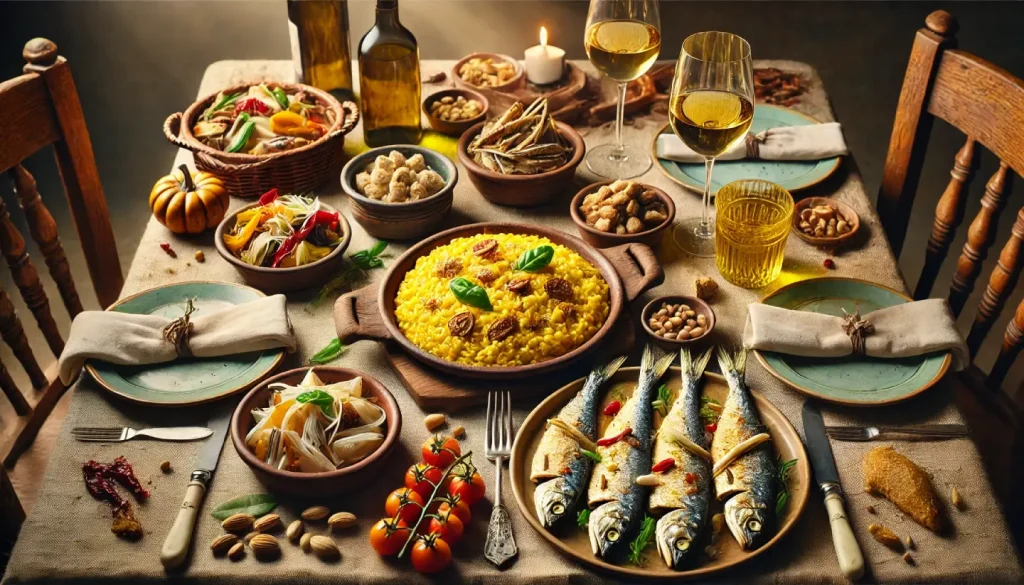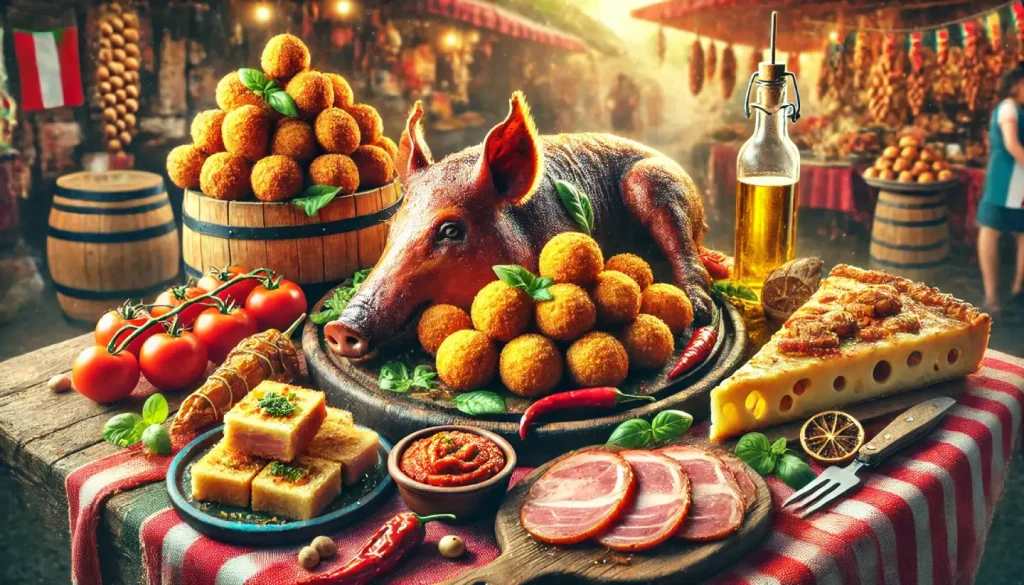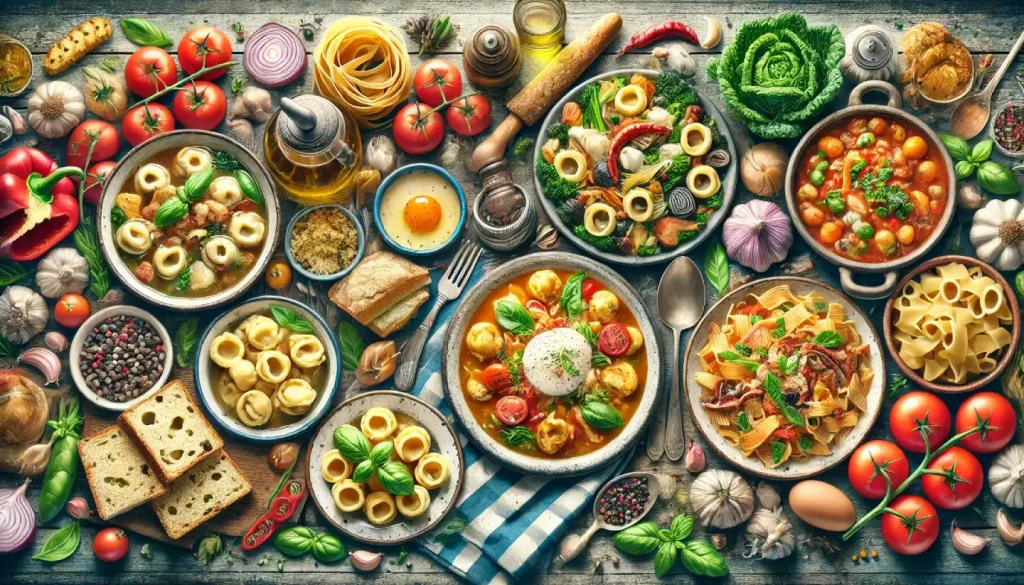
Italy is renowned worldwide not only for its history, art, and culture, but also for its unique and diverse cuisine. Each Italian region offers a range of flavors, ingredients, and culinary traditions that reflect its geography, climate, and local history. In this article, we will embark on a gastronomic journey through Italy’s regions, discovering the typical dishes that make each area unique in the global culinary landscape.
Lombardy: Risotto alla Milanese
Lombardy, located in northern Italy, is famous for its creamy risotto. Risotto alla Milanese, with its characteristic yellow color from saffron, is one of the region’s most iconic dishes. Made with Carnaroli or Arborio rice, butter, onion, white wine, meat broth, and a generous amount of Parmesan cheese, Risotto alla Milanese is a dish that highlights the simplicity and quality of its ingredients.
Piedmont: Bagna Cauda
Piedmont offers a cuisine rich in intense flavors, with dishes that express the best of rural and mountainous traditions. Bagna Cauda is a hot dip made with garlic, anchovies, and olive oil, typically served with raw vegetables like peppers, cardoons, fennel, and cauliflower. This dish represents a convivial moment, to be shared with friends and family.
Veneto: Sarde in Saor
The Veneto region, with its enchanting Venice, is known for its seafood dishes. Sarde in Saor is a traditional Venetian dish made with fried sardines marinated with onions, vinegar, pine nuts, and raisins. This dish has ancient origins and was originally created to preserve fish during long sea voyages. Its sweet and sour flavor is unmistakable and reflects the influence of oriental spices in Venetian cuisine.
Emilia-Romagna: Tortellini in Brodo
Emilia-Romagna is the heart of fresh pasta in Italy. Tortellini in Brodo is a classic from this region, especially in the provinces of Bologna and Modena. These small pasta rings filled with meat (usually pork, prosciutto, and mortadella) are served in a warm, flavorful broth. Their delicate taste and perfect texture represent the best of Emilia’s tradition.
Tuscany: Ribollita
Tuscan cuisine is known for its simplicity and the use of humble but high-quality ingredients. Ribollita is a rustic soup made with stale bread, beans, kale, potatoes, carrots, and onions. Traditionally, this dish was made with the leftovers from the previous day and ‘reboiled’ the next day, which is where its name comes from. It is a nourishing and flavorful dish, perfect for cold winter days.
Lazio: Pasta alla Carbonara
In the Italian capital, Rome, one of the most famous pasta dishes in the world was born: Pasta alla Carbonara. Made with guanciale (cured pork cheek), eggs, Pecorino Romano cheese, and black pepper, this pasta is an explosion of simple but intense flavors. Roman tradition dictates that carbonara should be prepared without cream to maintain its authenticity and original taste.
Campania: Pizza Margherita
Campania, and particularly Naples, is the birthplace of pizza. Pizza Margherita, topped with tomato, mozzarella, basil, and olive oil, has become a symbol of Italian cuisine worldwide. Simple yet irresistible, this pizza represents the perfection of combining fresh, high-quality ingredients.
Sicily: Arancini
Sicily, with its rich history of Arab and Norman influences, offers a highly varied cuisine. Arancini are deep-fried rice balls filled with ragù, peas, cheese, or other ingredients, and are one of the most beloved street foods in the region. Crunchy on the outside and soft inside, arancini are a burst of flavor and tradition.
Sardinia: Porceddu
In Sardinia, Porceddu (roast suckling pig) is the king of festive tables. Cooked slowly on a wood fire and flavored with aromatic herbs like myrtle and rosemary, the piglet becomes tender and flavorful. This dish represents the essence of Sardinian cuisine, which favors intense and genuine flavors.

Calabria: ‘Nduja
Calabria is famous for its strong and spicy flavors. ‘Nduja is a soft, spicy sausage made with pork, Calabrian chili peppers, and spices. This unique product is spread on bread, used to season pasta, or included in various dishes. ‘Nduja represents the Calabrian passion for bold and intense flavors.
Apulia: Orecchiette alle Cime di Rapa
Apulia, with its vast plains and olive groves, offers simple yet delicious cuisine. Orecchiette alle Cime di Rapa is a typical dish of the region, made with orecchiette (a small, ear-shaped pasta) and turnip tops, a type of vegetable with a slightly bitter taste. This dish is often enriched with anchovies, garlic, and chili, creating a unique flavor combination.
Liguria: Pesto alla Genovese
Liguria is world-famous for its Pesto alla Genovese, a bright green sauce made with fresh basil, pine nuts, garlic, Parmesan, Pecorino, and olive oil. Traditionally crushed in a marble mortar, this condiment is used to enhance pasta like trofie or trenette and represents the freshness and simplicity of Ligurian cuisine.
Abruzzo: Arrosticini
Abruzzo, with its mountains and hills, offers robust and flavorful dishes. Arrosticini are skewers of mutton or lamb meat, grilled over charcoal and simply seasoned with salt. This dish represents the pastoral tradition of the region and is perfect to enjoy during outdoor festivals.
Umbria: Torta al Testo
Umbria is a landlocked region, but it offers a cuisine rich in traditions. Torta al Testo is a flatbread cooked on a plate called a ‘testo.’ It is filled with various ingredients such as ham, sausage, vegetables, or cheeses and is a simple yet delicious dish that enhances local flavors.

Friuli-Venezia Giulia: Frico
Frico is a typical dish from Friuli-Venezia Giulia, made with potatoes and Montasio cheese. It is a sort of cheese fritter, crispy on the outside and soft on the inside. This dish represents the region’s rural tradition and is often served with polenta.
Conclusion
Each Italian region has its own culinary identity, reflecting local history, geography, and culture. The typical dishes of the different areas are not just food but also represent a journey into the tradition and passion of Italian cooking. For those who wish to explore Italy through taste, there is no better way than savoring the regional specialties, each with a unique story to tell.
FAQ – Frequently Asked Questions
- What is the typical dish of Lombardy?
- Risotto alla Milanese, known for its yellow color from saffron.
- What is Bagna Cauda?
- A hot dip from Piedmont made with garlic, anchovies, and olive oil, served with raw vegetables.
- What are the main ingredients of Pasta alla Carbonara?
- Guanciale, eggs, Pecorino Romano cheese, and black pepper.
- What is the most famous street food in Sicily?
- Arancini, deep-fried rice balls filled with ragù or other ingredients.
- What is Calabrian ‘Nduja?
- A soft, spicy sausage made with pork and Calabrian chili peppers.
- What is the typical dish of Apulia?
- Orecchiette alle Cime di Rapa, a pasta served with slightly bitter vegetables.



